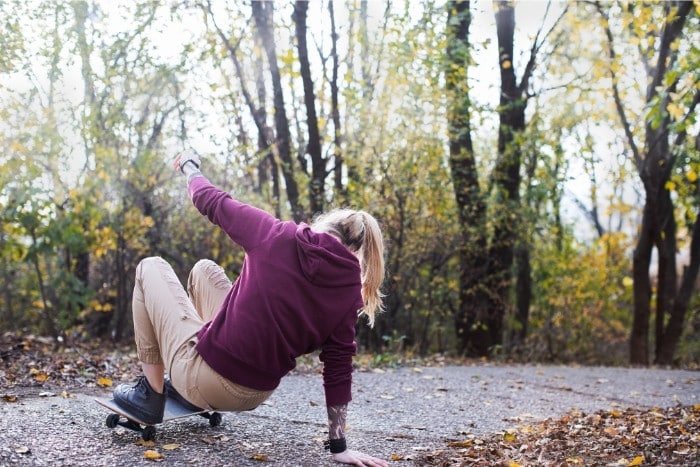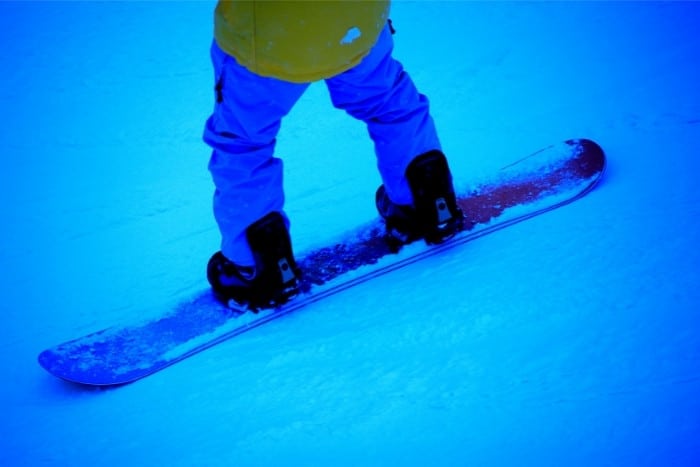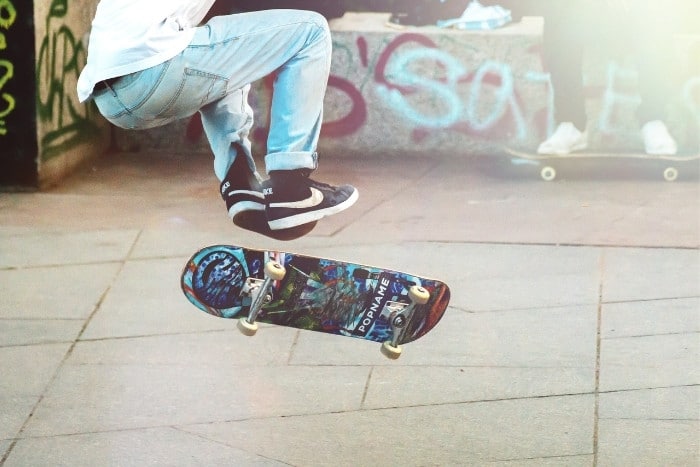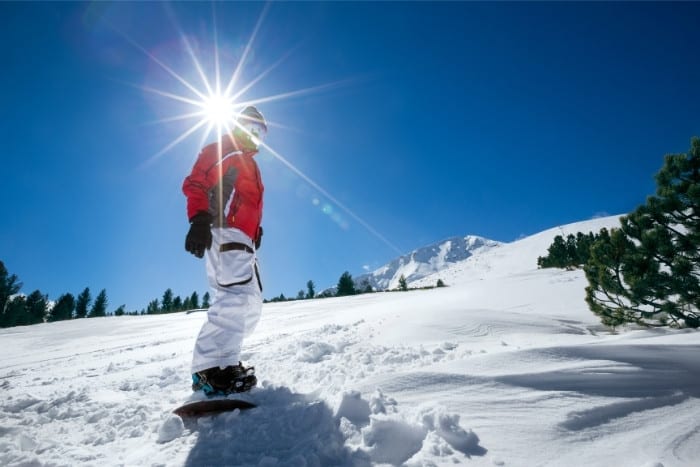As they are both board sports, snowboarding and skateboarding have various similarities, making it easy to transition from one sport to another. Snowboarding is an easy target if you are a skateboarder wishing to try a different sport.
Transitioning from skateboarding to snowboarding is relatively easy as you can transfer skills like balance, turns, agility, trick knowledge, and commitment. To make a smooth and faster transition, you first must understand the similarities and differences between the two sports.
After compiling the experiences of people who successfully joined snowboarding from skateboarding, here is an in-depth comparison of similarities and differences between the two sports to help you understand them better.
How to Snowboard if You Can Skateboard?
As a skateboarder who wishes to start snowboarding, you should consider the similarities and differences of the boards, sporting environment, risks, and ability to transfer basic skateboarding skills to snowboarding.
Comparing the listed factors prepares your mind and body to handle snowboarding requirements without much pressure.
1. Comparing Challenges
There are many similar challenges faced in skating and snowboarding. If you have been on a skateboard, chances are that you have endured falls, scratches, board damage, and failures in the beginner stages.
Understanding these feelings is a great way to prepare yourself to endure similar instances during snowboarding.
Picking yourself up after trying to land a trick in skateboarding and practicing to perfect that trick helps you understand your abilities.
You can rate your skills from your skating achievements and understand why you cannot perform certain tricks or moves.
When you get on the slopes, this knowledge will help you analyze situations, re-strategize, and come back stronger when you fail. Even if the snowboarding challenges differ from skateboarding.

2. The Boards
Snowboards and skateboards have similar designs but different features to suit the riding surfaces.
Before transferring from skateboarding to snowboarding, it would help to understand these similarities and differences, so you know how to operate a snowboard.
A snowboard has a nose, tail, camber, edge, and base.
The snowboard base is smooth and designed for sliding on snowy slopes; this is in contrast to a skateboard, which has wheels that enhance mobility on concrete and other rough surfaces.
If you can pull yourself across rough surfaces on your wheeled skateboard, you can adjust the skills to help you ride on the snowy slopes on your smooth-based snowboard.
One significant difference between the boards is that snowboards have bindings that allow you to strap your boots in and control your board.
Moving from a board where you can easily jump off when you’re about to bail to a board where your feet are stuck is a bit daunting at first.
3. Balance and Stance
Snowboarding is very similar to skateboarding in terms of balance and stance.
If you’re already a skater and want to try your hand at snowboarding, the balance and stance similarities between the two sports will make it easy for you to transition.
You may have an advantage over other beginners because of your balance from skateboarding.
It’s easier for people who are already good at balancing themselves on two wheels to balance on the smooth-based snowboard.
Once you learn how to stand on a board and move around, it’ll be even easier to snowboard because the skills serve as a foundation for learning new ones.
Skateboarding enables you to practice goofy and regular stances.
If you are a goofy-footer, your right foot will be more oriented to remain at the front as you use your left foot to push forward, and vice versa for a regular footer.
You can analyze which stance works best for you on a skateboard and maximize it when you start snowboarding.
You will be better equipped to understand whether putting your right foot forward works better than using the left foot in front of your snowboard’s nose when on the slopes.
A difference between skateboarding and snowboarding is the surface you’re standing on. In skateboarding, your board moves on a hard surface, such as concrete or wood.
In snowboarding, you mainly use your snowboard on snow, which is often softer than concrete.
However, you can opt to ride or perform tricks with your snowboard on boxes, rails, and ice, where the skateboarding skills come in handy.
In both situations, all that matters is your ability to balance and ride on the board.
4. Turning and Carving
Snowboards lack wheels and have a smooth base, which makes them better at going over snow.
To accommodate the difference between snowboards and skateboards, you may have to readjust your weight more when you turn on a snowboard.
When you turn on a skateboard, much of your weight is centered on the board.
On the contrary, when you turn on a snowboard, much of your weight will be shifted to one side of the board, depending on whether it’s a regular turn or a carve.
This may feel slightly scary when first snowboarding and may take some time to figure out the correct amount of pressure to apply.
Another difference between a skateboard and a snowboard is that the latter has edges that develop traction on the riding surface. These edges dig into the snow while you make turns.
When the edges are sharp, your board gains a strong grip which helps your turn more smoothly and gain more control.
This makes it a lot easier to control your board while turning at high speeds in comparison to skating.
5. Speed Control and Stopping
Your ability to control speed and stop on a skateboard can help you become a better snowboarder.
Performing a powerslide enables your skateboard’s wheels to skid, slow down and stop as you make an abrupt turn when in motion.
In comparison, stopping a snowboard requires applying pressure on your snowboard’s edge.
You’re required to lean low by bending your knees in both instances, and the higher pressure you exert on the board’s edge, the faster you make the stop.

6. Agility and Stability
If you’ve got the agility and stability skills from racing down the concrete on your skateboard, then there’s no reason why you can’t strap on a board and hit the slopes.
Skateboarding and snowboarding are similar in that they require a high level of agility and stability.
Both skateboarders and snowboarders use their entire bodies to maintain balance, making the transition to snowboarding easier.
7. Tricks Similarity
Skateboarding and snowboarding have a lot in common; they rely on the same body movements, leg strength, and balance.
The best way to learn new tricks is by combining your knowledge from one sport with what you learn as you practice the other. Skateboarding tricks that translate well to snowboarding include:
- Ollie – You can do ollies in the snow just like you would on concrete. Alternatively, you can perform a nollie instead of doing an ollie.
- Grabs- You can transfer your ability to perform skateboarding grab tricks into snowboarding. With practice, you’ll learn to make grabs and make your snowboarding experience more fun.
8. Learning Period
The learning period of picking up snowboarding is not very steep if you can already skate. In fact, some people say it’s almost non-existent!
If you already know how to skate, you’ll be surprised at how quickly you pick up on snowboarding.
Snowboarding is much like skateboarding because it involves sliding across a surface on your feet while facing forward.
This means that all the skills associated with riding a skateboard are transferable to riding a snowboard; you just have to learn how they apply in the snow.
9. Hazards
Skateboards are more maneuverable than snowboards, which means avoiding hazards on a skateboard is easier.
If you know how to avoid the most common hazards and risks while skateboarding, those skills will come in handy when you’re learning to snowboard, and continuous practice will help you improve your skills.
10. Riding Surfaces
Skateboarding and snowboarding involve riding a board, but their surfaces are different. While a skateboarder rides on pavement or concrete, a snowboarder rides on snow-covered hills.
The difference in surfaces makes it bearable to adjust if you are already used to navigating through concrete and other hard terrains.
However, you’ll require the skills and tricks applied when skating on concrete to snowboard on ice, boxes, rails, and surfaces that need more advanced skills.
If you’re used to skating on hard surfaces like concrete or asphalt, it shouldn’t take long to adjust your skills on the snow and improve your prowess.
Challenges in Transitioning from Skateboarding to Snowboarding
While transitioning from skateboarding to snowboarding is easy, you may face a few challenges that can interfere with skills transfer between the two sports.
From the factors like the surface or terrain listed in the following context, you’ll soon realize that things that pose advantages in this article’s first section can work against you as challenges.
However, understanding them from this perspective will help you practice better and wiser until you achieve your goal and make your skateboarding skills work to your advantage. The challenges include:
1. Snowboarding is Less Versatile
Skateboards are more versatile than snowboards because they can be used on various surfaces, including the street, half-pipe, or sidewalk.
There are many different styles of skating, allowing skaters to perform different types of tricks. In comparison, snowboards are only suitable for use on snow-covered hills or mountains.
You’ll need time to adjust and tone down on the many tricks you have been performing on your skateboard as you blend your skills on the skateboard.

2. It’s Hard to Adjust to the Different Riding Surface
It can be challenging to transition from concrete to snow when starting out in snowboarding.
That’s because skateboarding and snowboarding are two very different sports, and how you interact with surfaces is a big part of that difference.
Skateboarders ride on hard surfaces like concrete, while snowboarders ride on snowy slopes.
The main difference between riding a board on concrete and one on snow is how much traction you have.
Snowboarders have more grip than skateboarders because they have edges on their boards designed to grip the snow.
This gives riders better control over their boards when they’re going fast or doing tricks. You can sharpen your board’s edges to reduce resistance and increase its ability to cut into the snow with minimal energy.
3. Snowboarding is a Bit More Fluid in Movement
The biggest challenge when transitioning from skateboarding to snowboarding is learning to make the movement more fluid and connected.
The movement involved in keeping up your momentum when gliding through snow makes it harder to transition from skateboarding to snowboarding than the other way around.
4. Different Gear and Equipment
Skateboarding is a great way to stay active during the summer months. Once you’re ready to try something new during winter, moving from skateboarding to snowboarding may be a thoughtful idea.
An outstanding difference between the two sports is that snowboarding requires heavier clothing and gear than skating.
This can make it difficult for skaters who are used to light clothing and shoes that allow them to move quickly and with ease.
Another challenge is figuring out how to correctly set up your bindings, considering that a skateboard lacks bindings and you may not be familiar with operating them initially.
5. Cost of Equipment
Skateboarding gear is much cheaper than snowboarding gear, and a beginner can easily get started with a pair of shoes, a skateboard, wheels, and trucks.
The cost of average skateboarding gear is approximately $300, while you can own a complete skateboard for about $150.
However, to begin snowboarding, you may need to invest a lot of money in buying the right equipment and accessories.
You will require a good pair of boots, bindings, board, gloves, jacket, pants, and goggles. Depending on your chosen brand, this will require you to spend at least $1300 or more.
On the brighter side, some companies are now manufacturing low-cost snowboard brands for beginners who cannot afford high-end products like Burton or YES boards.
These brands come with complete sets which include everything from bindings to gloves but may force you to compromise on quality.
Can I Snowboard if I Can Skateboard: Final Verdict
When transitioning from one sport to another, there is never a one-fits-all formula to ease the process.
However, how fast you transfer your skills from skateboarding to snowboarding depends on your determination and love for the sport.
To answer your question on whether you can snowboard if you can skateboard, we advise you to put your best foot forward and try a practical experiment.
You may need an instructor to help you navigate the slopes as you learn how to sport in heavy gear and colder weather. Or you can ask some of your skater friends who snowboard to help show you the ropes.
Ensure you have all the required equipment to ease your transition and give you a smooth time picking up new skills. And most importantly, have fun while learning.
When switching to snowboarding, you can apply your knowledge and ability to use the skateboard by shifting your weight to balance on the snowboard.
You can also borrow skateboarding skills while turning, controlling your speed, stopping, maintaining agility, and avoiding risks.
Additionally, background knowledge and skills in skateboarding smoothen your learning curve when you start snowboarding.

Conclusion
Every sport is different but skateboarding and snowboarding have more similarities than differences.
Various factors make it easy to transition and transfer your skills from skateboarding to snowboarding, helping you enjoy the best of both sports as seasons vary.
Remember to understand the challenges of the skateboarding-to-snowboarding transitioning process and avoid surprises on the slope.
Comparing the positive factors and challenges will give you a sneak peek of what to expect when transferring your skateboarding skills to snowboarding.
The bottom line is you are more advantaged to snowboard if you can skateboard, so take the leap of faith and add the new sport to your list!
